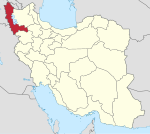| Jāme Mosque of Urmia | |
|---|---|
 The Grand Mosque of Urmia | |
| Religion | |
| Affiliation | Islam |
| Province | West Azerbaijan |
| Location | |
| Location | Urmia, Iran |
| Municipality | Urmia |
| Geographic coordinates | 37°33′03″N 45°04′33″E / 37.55088°N 45.0757583°E |
| Architecture | |
| Type | Mosque |
| Style | Azeri style |
| Completed | Ilkhanate |
The Jāme Mosque of Urmia (Persian: مسجد جامع ارومیه, romanized: Masjid-e-Jāmeh Orumieh), also known as the Rezayieh Mosque (مسجد رضائیه, Masjid-e-Rezayieh), is the grand, congregational mosque (Jāme) of Urmia, Iran.[1] The mosque is situated in the older part of the city and was constructed in 13th century during the Ilkhanate era.[2][3]
YouTube Encyclopedic
-
1/5Views:27 7236444811 1611 611
-
Urmia
-
urmiyeh, urmia, azerbayjan gharbi, فیلم تاریخی از ارومیه
-
Jami Masjid (Friday Mosque)
-
Esfahan Grand Bazaar & Masjed e Jameh (Jameh Mosque), Iran
-
A short walk through Yazd old town (Iran)
Transcription
Gallery
-
Plan of the building.
-
-
-
-
-
-
-
See also
References
- ^ "گردشی تاریخی در مسجد جامع ارومیه +عکس". Nov 2013. Retrieved 2014-08-21.
- ^ "معرفی مسجد جامع ارومیه". Feb 2009. Retrieved 2014-08-21.
- ^ "آشنایی با مسجد جامع ارومیه +عکس". Dec 2011. Retrieved 2014-08-21.
Further reading
- Anisi, Alireza (2023). "Saljuq Architecture in Iran: The Friday Mosque of Urmiya". Iranian Studies: 1–24. doi:10.1017/irn.2023.62.
- Fadaei Nezhad, Somayeh; Mollazadeh, Fatemeh; Hanachi, Pirouz (2021). "Evaluation of Authenticity in the Conservation and Development of the Jameh Mosque of Urmia". The Historic Environment: Policy & Practice. 12 (1): 53–76. doi:10.1080/17567505.2020.1824744.
- Kleiss, W. (1987). "AZERBAIJAN ii. Archeology". In Yarshater, Ehsan (ed.). Encyclopædia Iranica, Volume III/2: Awāʾel al-maqālāt–Azerbaijan IV. London and New York: Routledge & Kegan Paul. pp. 215–221. ISBN 978-0-71009-114-7.
- McClary, Richard; Danesh, Leila (2023). "A Tabrīzī School of Īlkhānī Stucco Carving? A Comparative Analysis of Īlkhānī Miḥrābs in Urmia, Marand, and Tabrīz". Der Islam. 100 (1): 164–212. doi:10.1515/islam-2023-0004.
External links
























